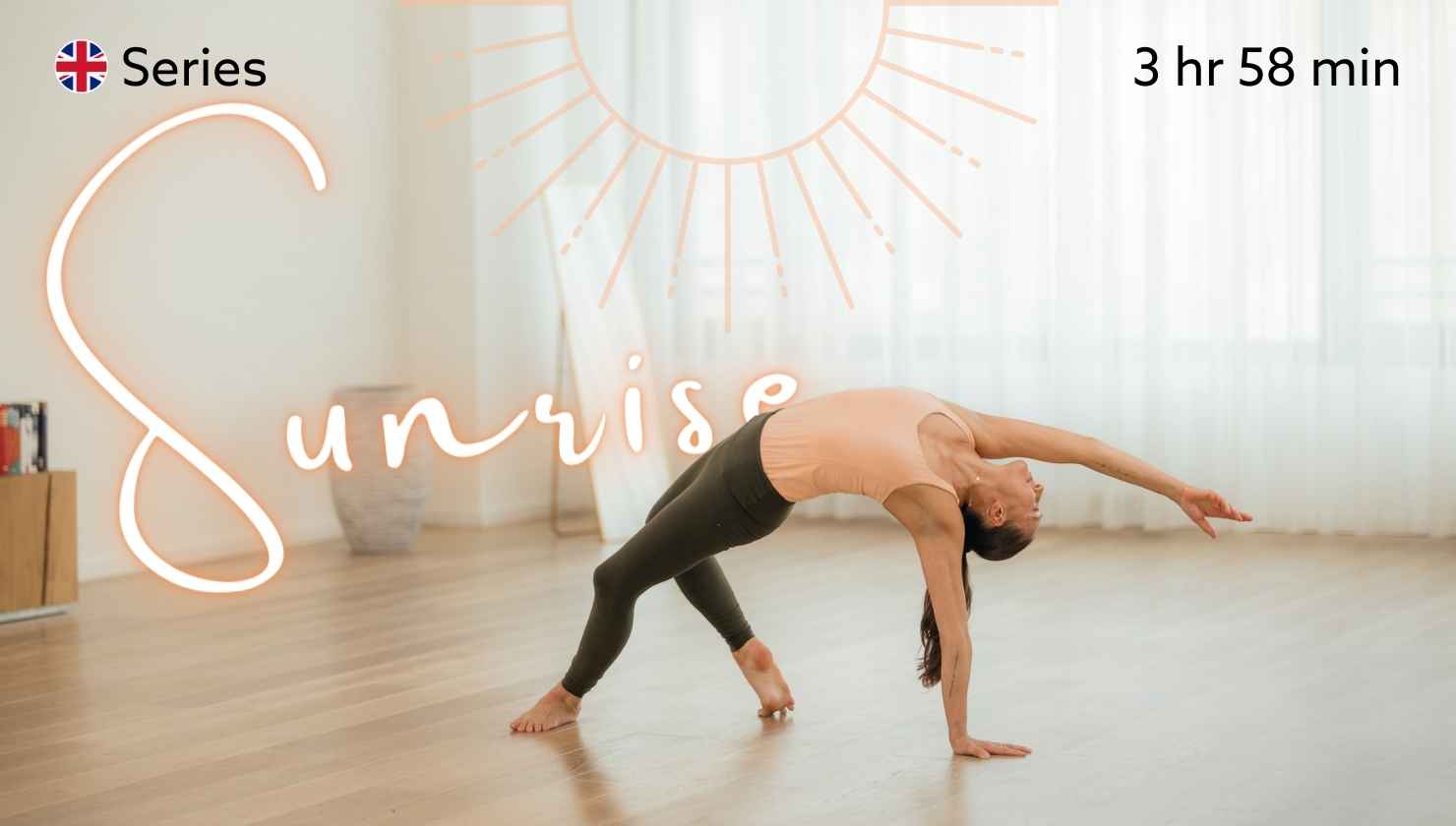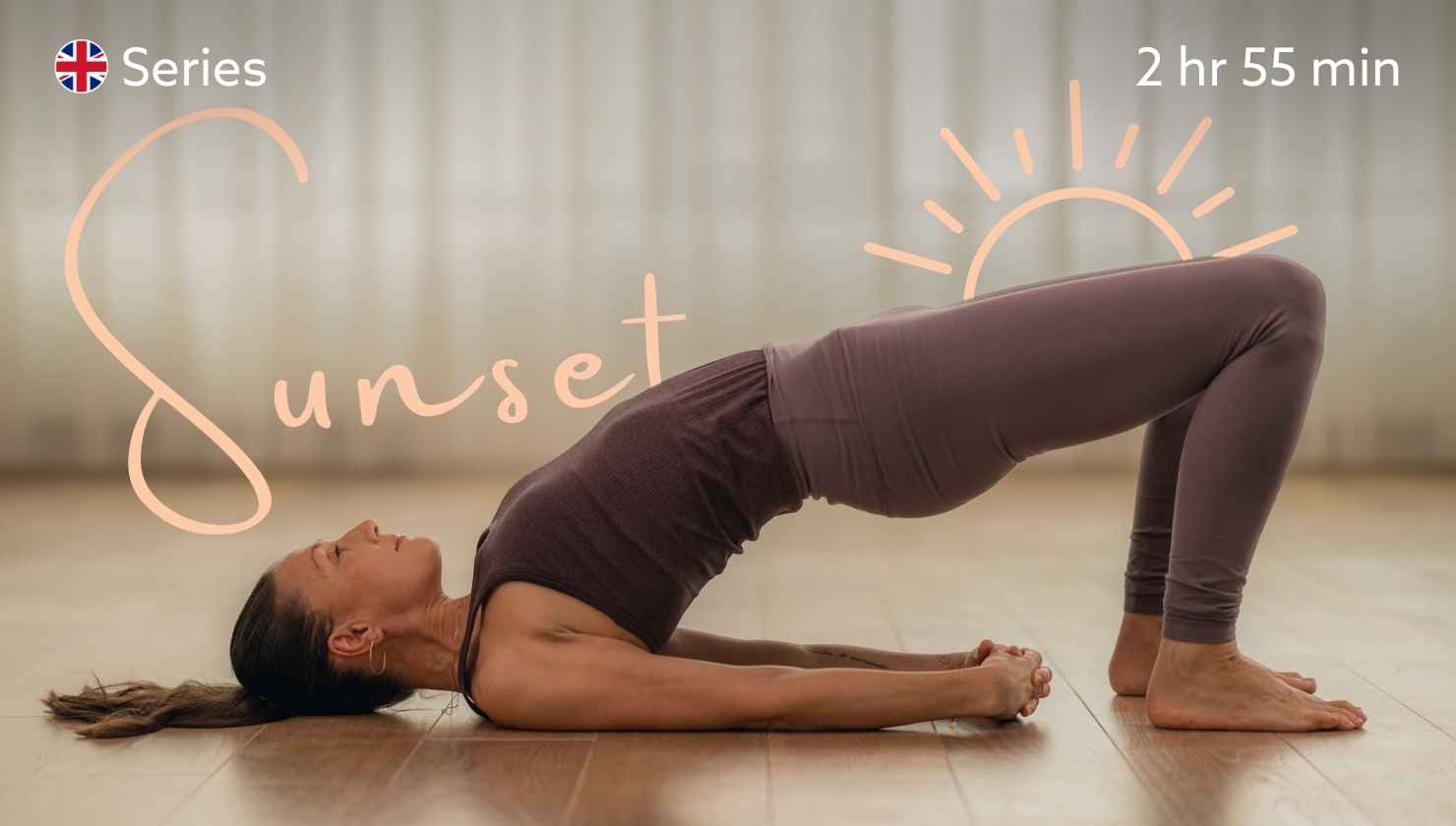Wouldn’t it be great to have a yoga room at home, or at least a little corner somewhere in your home – a calm, sacred space just for you?
Nothing compares to a warm, calm, and cozy yoga studio that creates a soothing atmosphere and makes you feel at peace as soon as you enter it.
However, the reality is that not everyone can go to their favorite yoga studio as often as they would like to. Sometimes, life gets in the way.
The good news – and one of the greatest things about yoga – is that it doesn’t take much to create room for your yoga practice in your home. Yoga can practically be done anywhere without a bunch of bulky equipment.
We have gathered a few tips for you on how to create, design, and decorate your yoga room or corner in your home so that you can dive into your yoga practice – with a completely present and grounded mind.
You will get:
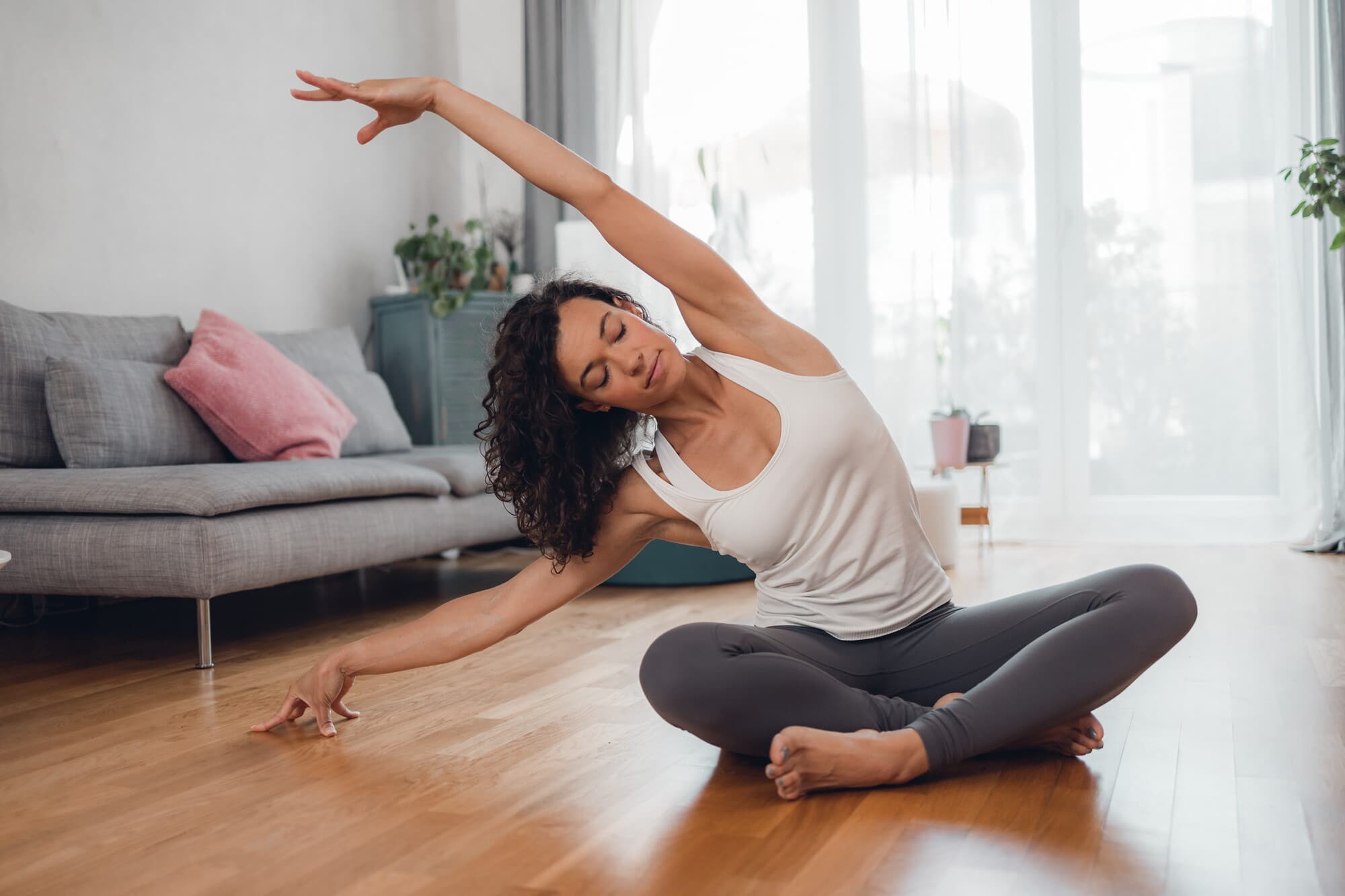
Sometimes, a small space in your living room is enough to practice yoga. Photo: TINT Instructor Ami Norton.
1. 5 Reasons for a Yoga Room at Home
But let’s start with another question: Why in the world would you need a dedicated space for your yoga practice in your home?
Well, as already mentioned, sometimes your schedule or other responsibilities like work, family, friends, etc. won’t allow you to commute to a yoga studio as often as you’d like. But maybe, you don’t feel safe practicing yoga around other people because you’re introverted, injured, or feel insecure for other reasons.
Maybe, other restrictions prevent you from gathering with many people. In such cases, it’s great to have your own space for your yoga session at home where you can practice for yourself or use online platforms such as TINT.
But why don’t you just practice anywhere? Well, asana practice is best done in a separate and soothing place that brings you into a peaceful state of mind – far away from the stress of the outside world. For most people, this is not possible between your kids’ toys, work documents, and dirty dishes.
Apart from that, a dedicated spot for your at-home yoga practice acts as a little reminder to get on the mat regularly. It can also motivate you and get you in the right mood to step on your yoga mat and move. Simply put, a yoga room at home helps your brain to switch into the “yoga mode”.
Let’s look at 5 reasons to create a yoga room at home.
Reason #1: Focus
Once you’ve created a separate spot for your yoga practice – be it an entire separate room, a small nook or corner – it will become your own sacred territory. This way, you can actually train your mind to switch off and let go of any thoughts and worries about your social life, the household, work, or other things that bother you. As soon as you step into your yoga area, you’ll be able to focus on yourself and your yoga practice.
The good thing about a separate yoga space is that you can prevent others from coming in and disturbing your practice. The same goes for any other distraction such as electronic devices: Your smartphone or laptop has nothing to do in your yoga space unless you use it to stream online yoga videos or play music. In that case, make sure you turn off any other notifications while practicing.

A yoga room at home is great if you love to practice yoga online with providers like TINT.
Reason #2: Motivation
You probably know these days when you simply don’t feel like doing anything. Even though you know how good you feel after a yoga session, you sometimes just don’t want to practice at all. However, if you have a nicely decorated yoga room at your home where you feel comfortable, it will be much easier for you to step on your yoga mat.
You can also trick yourself by simply enjoying the coziness and beauty of your yoga spot and casually sitting on your yoga mat. Maybe you want to switch on your favorite yoga music, light some candles and incense sticks and – all of a sudden – your body starts to move and stretch and you’re in the middle of your yoga practice.
Reason #3: Relaxation
The same trick may help you to calm down and find relaxation after a stressful day or before a full day ahead. Wouldn’t it be great to have a tiny little physical space just for you to give your mind some rest and get some emotional space, too?
Just give it a go: Whenever you feel sad, vulnerable, anxious, or stressed, back off into your yoga room at home, indulge in your favorite music, candlelight, and the smell of incense sticks. Allow yourself to enjoy the stillness and relaxation with this little self-care treatment.
Reason #4: Mindfulness
Here’s the best thing: You don’t have to use your yoga space exclusively for your asana practice. Instead, consider it a room for yourself where you can spend some time without any distractions: Use your yoga room for journaling, reflecting, meditating, reading, and any other mindfulness practices and routines.
Reason #5: Creativity
While you don’t have to be an interior designer, decorating and setting up your own yoga room at home can be so much fun! This is a great chance to discover your creative side. Even more so with all the beautiful accessories and tools for yoga that you can easily buy on the internet nowadays.
And if you want to be really serious about that, you can even handcraft parts of your decorations yourself such as dream catchers, tapestry, or macrame. This way, you can add an even more personal touch to your yoga corner.
In the end, it all comes down to your own intention: Do you want to create a space for your yoga (asana) practice, create a little reminder to practice yoga, or set up a sacred space just for your own well-being?
“Your sacred space is where you can find yourself again and again.”
2. 9 Tips How to Set Up a Yoga Room at Home
As already mentioned, your yoga space doesn’t necessarily have to be an entire room at home, it can be a small corner in your bedroom, living room, or any other room that allows enough space. Don’t limit yourself because you want too much: sometimes a tiny niche with a candle and a small rug is enough to give you the space to focus on yourself.
It also depends on the yoga style you want to practice: While you will need more space for Inside Flow or Vinyasa yoga, you don’t need much for calmer practices such as Yin yoga or meditation.
The most important thing to remember is to keep it simple. Setting up a yoga room or corner at home can be as easy as that:
1. Make some space.
2. Roll out your yoga mat.
3. Make sure you remain undisturbed.
4. Practice.
However, if you mean serious business, you can get as crazy as you want here. We have collected 9 tips that help you to set up your own yoga room at home or create your own little yoga corner.
Tip #1: Declutter the Space
A cluttered space leads to a cluttered mind. So, if you want to focus your attention on your yoga practice, it’s essential to remove anything you don’t need for that purpose. Only invite things into your yoga space at home that are either functional or inspirational. Take out everything else. Otherwise, your mind will feel overwhelmed and restless.
This means that you should get rid of any unnecessary stuff in the room like clothes, books, electronic devices, etc. Remove any tables or chairs (or, at least, move them aside).
Also, avoid overdoing it with decorations and accessories. Keep it simple but tasteful. Many yoginis and yogis find it actually most inspiring to have nothing but the yoga mat in their yoga space. This way, it’s easier to stay focused and not get distracted.
Tip #2: Bring in Nature & Plants
Our chaotic and busy lives rarely give us the chance to go out regularly and enjoy the calming effects of nature. Researchers found that spending time in nature helps with mental health problems such as anxiety and depression. There’s also strong evidence that the green color has a calming and relaxing effect on the human organism.
However, not everyone is lucky enough to be surrounded by beautiful green nature. But you can bring nature into your yoga room at home with indoor plants.
Studies have shown that indoor plants may reduce stress by suppressing autonomic nervous system activity. So, making your yoga room a greener space is one of the best things you can do for yourself.
And by the way: If you don’t have a green thumb, you can at least use artificial plants or a bouquet of flowers that you exchange frequently.
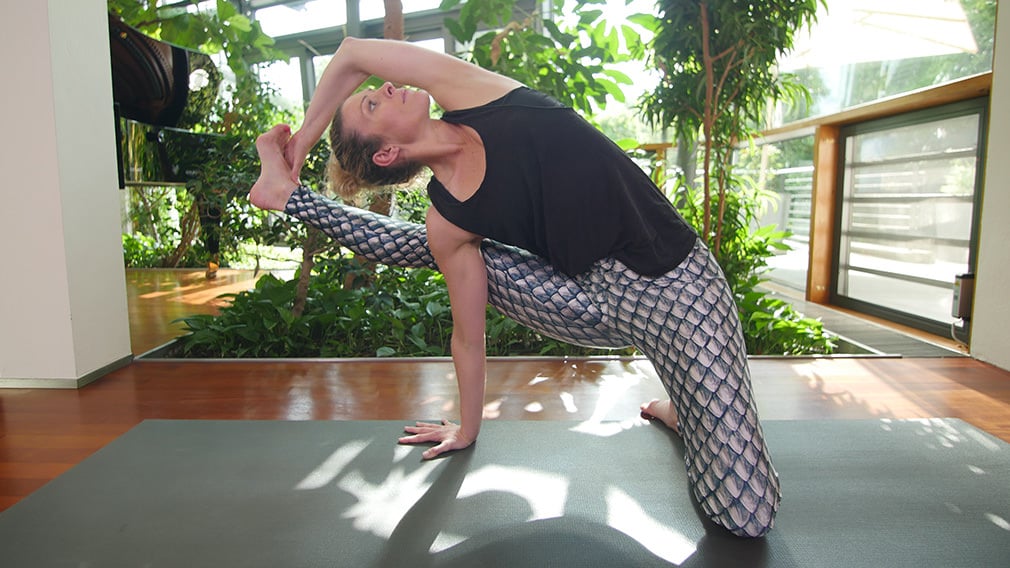
Bring nature into your yoga room with indoor plants. Photo: TINT Instructor Alexandra Harfield.
Tip #3: Choose the Right Lighting
The next element to consider is the lighting in your yoga space at home. If you can, opt for natural light rather than artificial light. However, if there’s no natural sunlight in your yoga room, choose lighting that comes as close as possible to natural light.
Soft white light mimics daylight bulbs while bright artificial lights can cause eyestrain and headache – certainly nothing you want to deal with during your yoga practice!
If possible, adjust the direction of overhead lamps in such a way that they shine down on you instead of directly into your eyes. This avoids confusing and annoying shadows. If electric light doesn’t work at all for you, you can also consider the possibility of using candles only.
Tip #4: Pick Suitable Colors
Color is another critical element in making your yoga room at home as inviting and comforting as possible. This really is a matter of taste: Use any colors that help you relax during your yoga sessions. However, you may find that earthy tones such as green and brown or light cool tones such as blue and lavender will have the best soothing effect on your nervous system.
You may also want to avoid bright colors such as red or yellow as they tend to be stimulating rather than soothing. However, if that is more what you need for your yoga practice at home, go for it!
Also, keep the contrasts low and avoid mixing up light and dark colors. This does not only look odd but can also create headaches. In general, soft and calm colors may be the best choice for a relaxing space to practice yoga or meditate.
Tip #5: Decorate the Walls
The easiest and cheapest way to decorate your walls is by using posters and tapestries. They also look very stylish and are super versatile. They can vary from photos of natural items or landscapes to patterns or mandalas and will bring a completely different energy to the walls of your yoga room.
If you want to create a more spiritual environment, you can choose posters or tapestries with pictures of Hindu gods or other yogic, ayurvedic, and zen posters that serve as inspirational guides for your yoga practice. You could even hang up a picture of your guru or a poster of a specific yoga sequence that you enjoy practicing.
If you don’t have a full room dedicated to yoga, tapestries and posters are also a great way to separate your yoga corner from the rest of the room.
Tip #6: Install Mirrors for Alignment
Especially for your home yoga practice, where you can’t benefit from the hands-on adjustments of an experienced yoga teacher, it’s crucial to stay properly aligned in order to avoid injuries. Mirrors are a great tool for that and complete the yoga studio vibe at your home yoga space. What’s more, they make even a small corner feel more open and spacious.
Especially yoga beginners may find it helpful to practice in front of a mirror until they learn how their bodies should align in certain poses. Consider it a valuable tool that helps you train your body intelligence.
If you find big mirrors distracting, you can opt for smaller decorative mirrors. They will not only help you with posture guidance but will also turn a simple white wall into a fancy piece of your yoga space.
Tip #7: Use Candles, Scents & Essential Oils
Scents are a powerful grounding force. Maybe you already noticed how the smell of certain foods awakens childhood memories or how certain smells remind you of particular people or situations. Assuming that these are good memories, you will instantly get into a more peaceful and balanced state of mind.
You can use this same psychology to train your brain to reach a state of peacefulness when you step onto your yoga mat in your yoga room at home.
One possibility to please your olfactory senses is using essential oils and natural candles. If you want to add a more spiritual element to your yoga practice, you can even use different scents to target specific Chakras or promote specific feelings.
If that sounds comforting to you, you can also burn a bundle of healing herbs to clear the energy in the room before your yoga practice.
The great thing about using candles, scents, and essential oils in your yoga room or corner is that your entire home will smell amazing.
Apart from that, research suggests that “fragrances may directly and/or indirectly affect the psychological and physiological conditions of humans. [… They] can also significantly modulate the activities of different brain waves and are responsible for various states of the brain”.
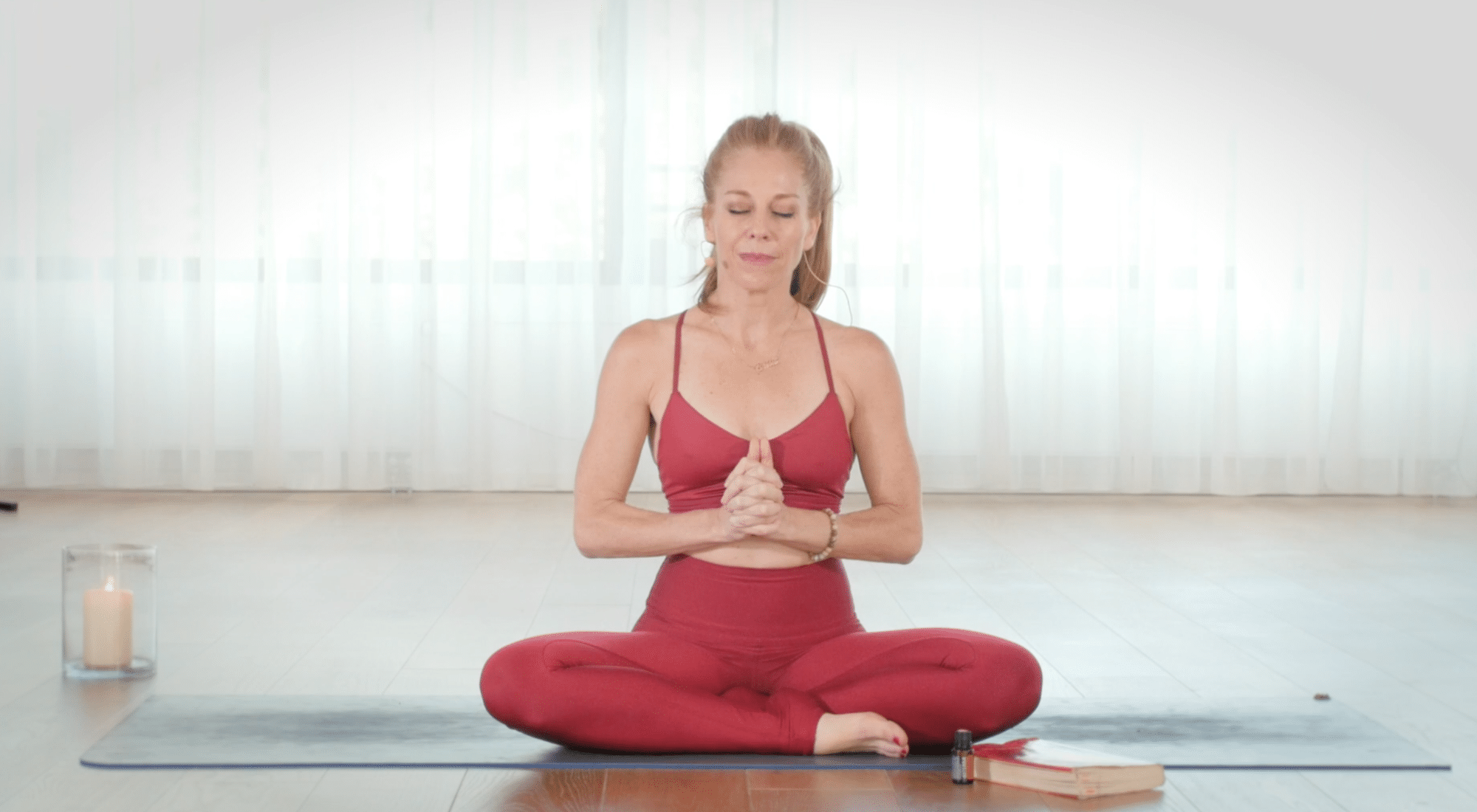
Candles help you to get in the right mood in your yoga room. Photo: TINT Instructor Cristi Christensen.
Tip #8: Include Spiritual Elements
If you’re a rather spiritual yogi, you may want to take the decor of your yoga room one step further by creating a small altar of crystals, miniature statues, a beautiful piece collected from nature and other spiritual elements. If that helps you to ignite your soul, connect to your inner wisdom, and bring fresh energy into your yoga practice, go for it!
Crystals and gemstones, for example, are commonly used by yogis to enhance your energies, support your intention, and increase your inner strength. Anyway, even if you don’t believe in the healing powers of crystals, they are beautiful decorative elements that create a truly yogic feeling in your yoga space at home.
And even if you’re not so much on the spiritual side, small yogic figurines can also add a nice touch to your yoga space, make you smile, and remind you to practice and meditate.
Another piece of decoration that fits nicely into your yoga space is a singing bowl – either for pure decorative purposes or to use its sound to get you into the right mood for the yoga practice. Which brings us to the next tip.
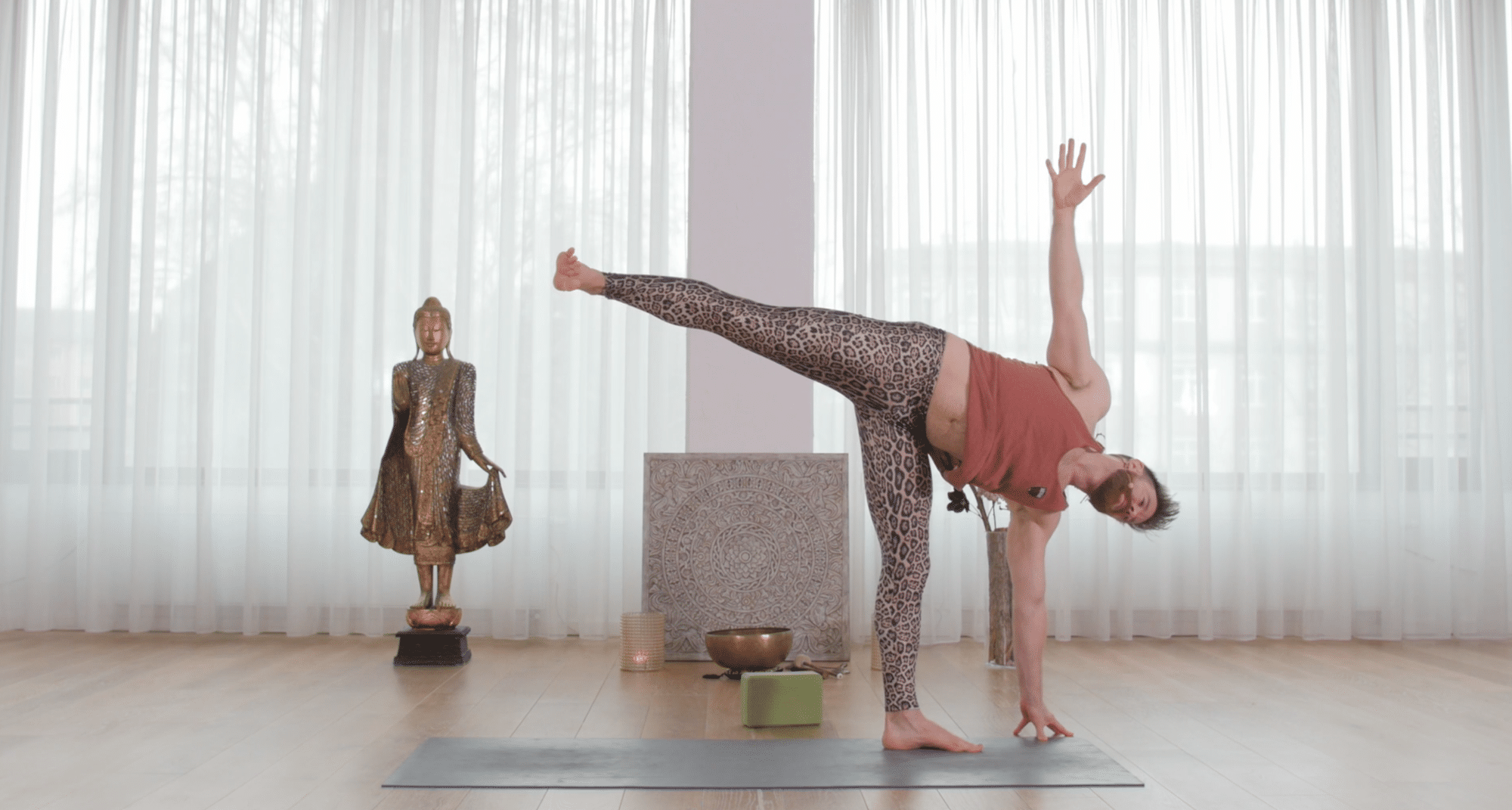
If you want, you can add spiritual elements like little figurines to your yoga space. Photo: TINT Instructor Finlay Wilson.
Tip #9: Think About Sound
The last – often neglected – element we want to look at is sound. That is, if you prefer to practice in complete silence, you don’t need to worry about that.
However, if music helps you to get into a flow state of mind, you should definitely think about the sound system you want to use. This becomes even more important if you practice a yoga style that includes music as a crucial part of the practice, such as Inside Flow.
Also, since you’ll probably be using your yoga room at home during the day, ambient noise such as traffic or other sounds from outside your window can sometimes be disruptive. In that case, you can use music or nature sounds to drown out these outside noises.
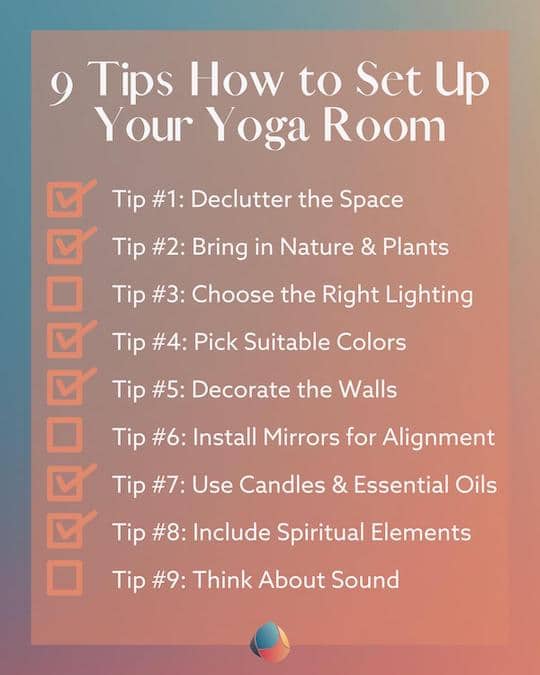
Your ultimate checklist for your yoga room at home.
3. Tools You Need in Your Yoga Room at Home
After you’ve set up your yoga room or yoga corner at home and thought about all the decorative and organizational things, it’s time to look at the most important question when it comes to designing your yoga space: What to put in there?
Well, first of all, think minimalistic. A yoga room doesn’t have to be complicated. It can actually be as simple as rolling out your yoga mat. And that’s it.
If you want to have more equipment, you can add yoga blocks, straps, blankets, and bolsters that you can use to support you in certain poses.
If you don’t want to invest in these tools right away, you can use things you already have at home: Use blankets instead of mats, books instead of blocks as props for poses, and pillows or cushions instead of bolsters. Scarves or belts are in no way inferior to “proper” yoga belts and will work just fine.
Simplicity is key here. The less the better. Especially if you’re just starting with your home yoga practice, avoid adding too much to the room as this may feel overwhelming. Keep it simple and wait until you get a better feeling for what you really need for your yoga practice.
Finally, keep in mind that yoga is not about having the latest and fanciest accessories and tools. And it’s not about showing them off, either. Yoga rather is about quieting your mind and moving toward more awareness and inner peace.
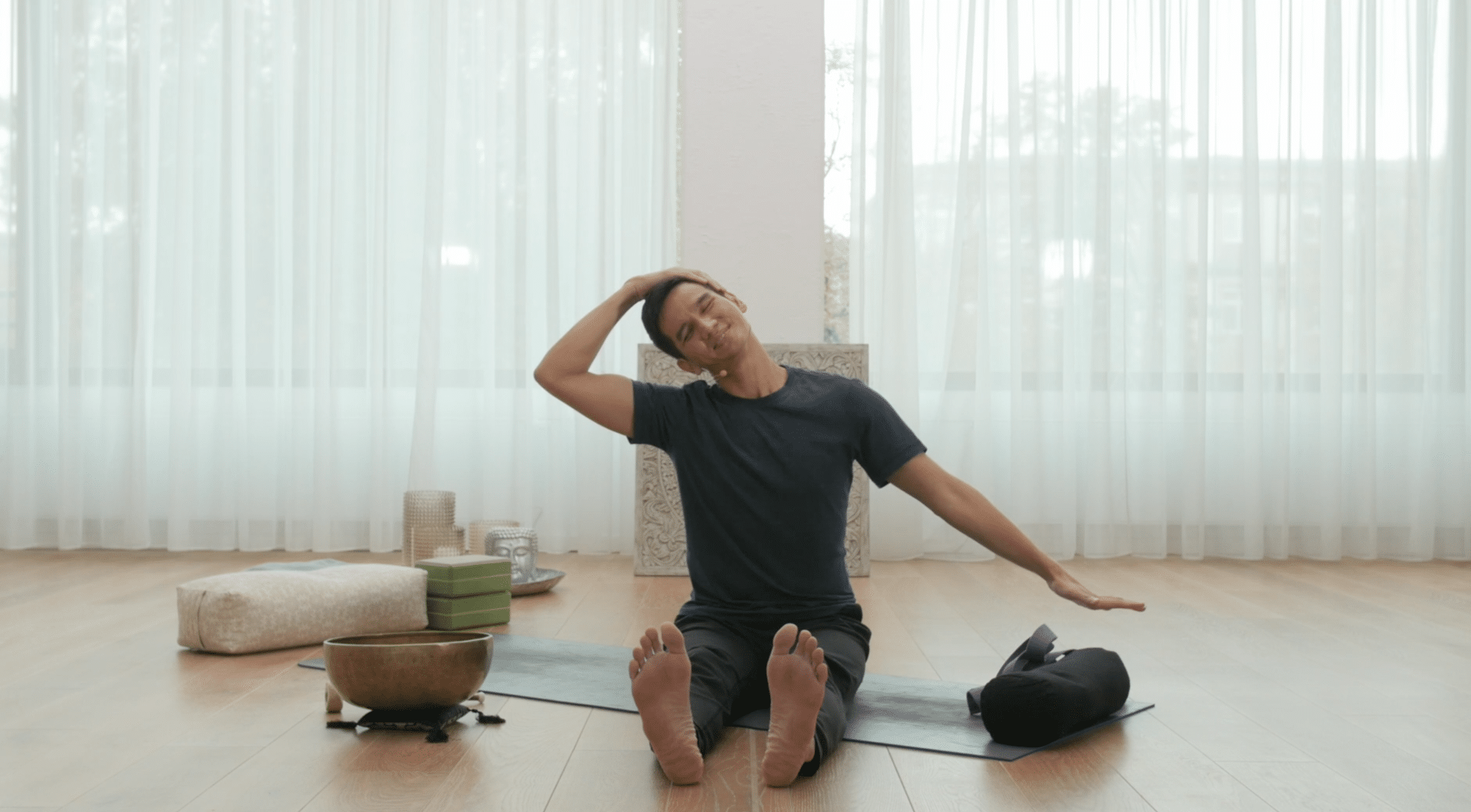
You don’t need a lot of equipment for your yoga room at home. Photo: TINT Instructor Chris Su.
You got your yoga room at home ready? Then hop on the mat and start practicing right away! If you need guidance or simply some inspiration, you’ll definitely find something on TINT Yoga. Whether you want to Find Your Flow or are looking for a Sunset or Sunrise yoga routine, we’ve got you covered. Oh, and never (!) skip Shavasana – not even when you’re alone at home in your yoga space. Don’t deny yourself the sweet and calming benefits of your final relaxation. Calm Down with Shavasana is the perfect guidance to find peace at the end of your yoga session at home.


